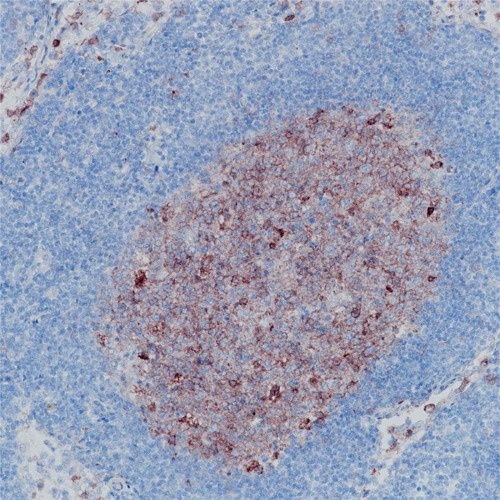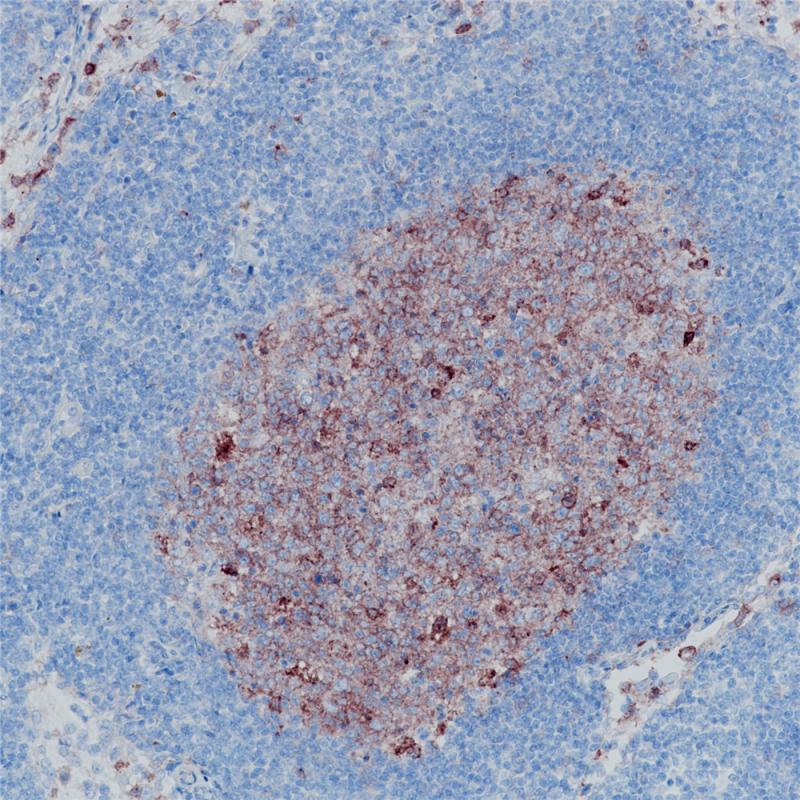CD10 Rabbit Monoclonal Antibody(ARB836)
CAT.NO. : ARB6626
RMB Please choose
RMB Please choose
Size:
Trail, Bulk size or Custom requests Please contact us
*产品价格可能会有所调整,请以品牌方官网实时更新的价格为准,以确保准确性。
Background
CD10 is a single-chain cell surface glycoprotein, also is designated as common acute lymphoblastic leukaemia antigen (CALLA), neprilysin and neutral endopeptidase. Besides, CD10 is a zink-dependent peptidase (metalloprotease), degrading various bioactive peptides, and it plays a functional role by modulating cellular responses to peptide substrates.
CD10 is present on the cell surface of bone marrow stem cells and myelopoietic cells (including neutrophils), follicular centre cells, few mature B-lymphocytes, and a subpopulation of parafollicular T-lymphocytes. CD10 is also found in enterocytes in the upper part of the intestinal tract (brush border), in liver (bile canaliculi), kidney (glomerular and proximal tubular cells), pulmonary alveolar cells, myoepithelial cells of breast and sweat and salivary glands, prostate glandular cells, placental rophoblastic cells, endometrial stromal cells, some endothelial cells, and a minority of (myo-)fibroblasts (including skin periadnexal cells). CD10 is expressed in a high percentage of cases of acute lymphoblastic leukemia, follicular lymphoma, Burkitt's lymphoma, some hematopoietic tumors, and chronic myelogenous leukemias in lymphoid blast crisis.
CD10 is particularly useful in the classification of B-cell leukaemias/lymphomas and classification of carcinomas (identification of hepatocellular carcinoma and renal cell carcinoma). CD10 may be used in the identification of metaplastic breast carcinoma, prognostication of breast carcinoma, and classification of uterine mesenchymal neoplasms (identification of stromal sarcoma).
CD10 is present on the cell surface of bone marrow stem cells and myelopoietic cells (including neutrophils), follicular centre cells, few mature B-lymphocytes, and a subpopulation of parafollicular T-lymphocytes. CD10 is also found in enterocytes in the upper part of the intestinal tract (brush border), in liver (bile canaliculi), kidney (glomerular and proximal tubular cells), pulmonary alveolar cells, myoepithelial cells of breast and sweat and salivary glands, prostate glandular cells, placental rophoblastic cells, endometrial stromal cells, some endothelial cells, and a minority of (myo-)fibroblasts (including skin periadnexal cells). CD10 is expressed in a high percentage of cases of acute lymphoblastic leukemia, follicular lymphoma, Burkitt's lymphoma, some hematopoietic tumors, and chronic myelogenous leukemias in lymphoid blast crisis.
CD10 is particularly useful in the classification of B-cell leukaemias/lymphomas and classification of carcinomas (identification of hepatocellular carcinoma and renal cell carcinoma). CD10 may be used in the identification of metaplastic breast carcinoma, prognostication of breast carcinoma, and classification of uterine mesenchymal neoplasms (identification of stromal sarcoma).
Overview
| Target | CD10 |
| Host Species | rabbit monoclonal antibody |
| Molecular Weight | 86 kDa |
| Purity | ProA affinity purified IgG |
| Species Cross-reactivity | Human |
| Form | Liquid |
| Applications | IHC-P |
| Swissprot ID | P08473 |
| Immunogen | Recombinant protein corresponding to CD10 residues within aa1-500 |
| Storage Buffer | PBS 59%, Sodium azide 0.01%, Glycerol 40%, BSA 0.05% |
| Storage Conditions | -25°C to -18°C |
| Dilutions | IHC-P: 1:100-1:200 |
| Subcellular Location | Membrane |
| Recommended Method | Heat induced epitope retrieval with Tris-EDTA buffer (pH 9.0), primary antibody incubate at RT (18°C-25°C) for 30 minutes |
Data

Immunohistochemical staining of human tonsillar tissue sections was performed using CD10 Rabbit Monoclonal Antibody (ARB836).
Storage
Store at 4°C short term. For long term storage, store at -20°C, avoiding freeze/thaw cycles.
Research Use Only
For Research Use Only. Not for use in diagnostic procedures.
 New Products
New Products




















